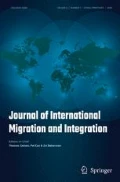Abstract
This paper considers the responses of three English primary schools to the education of their Muslim pupils. It begins by setting out the context of discussion about Muslims and education in Europe as well as by describing some of the structural and pedagogical characteristics and trends in English education influencing the schools’ options and choices. The main body of the article is a comparative analysis of the three schools, focusing on the approaches of teachers and school leaders to the faith backgrounds of their pupils, their constructions of Islam for these educational contexts, and their preparation of Muslim children for a religiously plural Britain. As the schools devise strategies and select between options, they provide in microcosm differing models of the inclusion of minority Islam in a western society.
Résumé
Cet article décrit la manière dont trois écoles primaires anglaises répondent aux besoins de leur clientèle majoritairement musulmane. Les auteurs font état, dans un premier temps, des débats sur l’éducation et les musulmans en Europe ainsi que de certaines caractéristiques et tendances structurelles et pédagogiques de l’éducation en Angleterre qui influencent les possibilités et les choix des écoles. Le cœur de l’article consiste en une analyse comparée de ces trois écoles, mettant l’accent sur la manière dont les personnels dirigeant et enseignant prennent en compte les croyances religieuses de la clientèle scolaire, construisent les savoirs sur l’islam dans ce contexte particulier et préparent leurs élèves musulmans à vivre dans une Grande-Bretagne multiconfessionnelle. Comme les écoles ont chacune des stratégies et des options différentes, elles représentent un microcosme de différents modèles de la manière dont on peut assurer l’inclusion de l’islam minoritaire au sein d’une société occidentale.
Similar content being viewed by others
Notes
Including the religious viewpoints and experiences of Muslim students in an environment that is both plural and secular in this journal.
Articles in this journal (Lorcerie and Ipgrave) demonstrate differences between French and English educational cultures. For a wider range of European educational systems and cultures with particular reference to religion in education, see Jackson et al. (2007).
The translation ‘religious facts’ does not convey the full sense of this term.
For more information about ‘religious character’ designation, see Department for Children, Schools and Families (2007) Faith in the System: the role of schools with a religious character in English education and society.
Around one third of state-maintained schools and nearly two out of every independent school have a ‘religious character,’ the huge majority being church schools.
These acts of collective worship are to be “wholly or mainly of a broadly Christian character” unless a school requests and obtains ‘determination’ from the Local Authority’s Standing Advisory Committee for RE releasing it from this clause though not from the obligation to provide collective worship. Determinations are usually granted where the majority of the school population is of a faith other than Christianity.
References
Berner, A. R. (2006). Is English education secular? In J. Garnett, M. Grimley, A. Harris, W. Whyte, & S. Williams (Eds.), Redefining Christian Britain: post 1945 perspectives (pp. 222–32). London: SCM.
British Humanist Association. (2006). A better way forward—BHA policy on religion and schools (revised). London: British Humanist Association.
Coles, M. I. (2008). Every Muslim child matters. Stoke: Trentham.
Fabos, A. (2005). Muslim immigration. In M. J. Gibney & R. Hansen (Eds.), Immigration and asylum from 1900 to the present (pp. 434–339). Santa Barbara: ABC-CLIO.
Daun, H., & Arjmand, R. (2005). Education in Europe and Muslim demands for competitive and moral education. International Review of Education, 51(5/6), 403–426.
Department for Children, Schools and Families. (2004). Every child matters: Change for children in schools. A Summary of DfES Guidance – DfES/1089/2004. London: DCSF.
Department for Children, Schools and Families. (2005). Social and emotional aspects of learning: Improving behaviour, improving learning DCSF-0110-2005. London: DCSF.
Department for Children, Schools and Families. (2007). Guidance on the duty to promote community cohesion July 2007 DCSF-00598-2007. London: DCSF.
Office, H. (2001a). Building cohesive communities: A report of the Ministerial Group on Public Order and Community Cohesion. London: Home Office.
Office, H. (2001b). Community cohesion: A report of the Independent Review Team chaired by Ted Cantle. London: Home Office.
International Helsinki Federation for Human Rights [IHF]. (2005). Intolerance and discrimination against Muslims in the EU. Developments since September 11. Vienna: IHF.
Jackson, R., Miedema, S., Weisse, W., & Willaime, J.-P. (Eds.). (2007). Religion and education in Europe: Development, contexts and debates. Münster: Waxmann.
Jackson, R., Ipgrave, J., Hayward, M., Hopkins, P., Fancourt, N., Robbins, A., et al. (2009). Materials used to teach about world religions in English schools. London: Department for Children, Schools and Families.
Karic, E. (2002). Is Euro-Islam a myth, challenge or real opportunity for Muslims and Europe? Journal of Muslim Minority Affairs, 2, 435–442.
Maylor, U., & Read, B. (2007). Diversity and citizenship in the curriculum: Research review. London: Department for Education and Skills.
Muslim Council of Britain. (2007). Towards greater understanding: Meeting the needs of Muslim children in state schools. London: MCB.
Open Society Institute (OSI). (2005). British Muslims and education. Budapest: Central European Press.
Parliamentary Assembly of the Council of Europe (PACE). (2005). Recommendation 1720 (2005). ‘Education and religion’. Strasbourg: Council of Europe.
Romain, J. (2008) Face to faith. The Guardian
Parliament, U. K. (1988). Education Reform Act 1988. London: Her Majesty’s Stationery Office.
Parliament, U. K. (1992). Education (Schools) Act 1992. London: Her Majesty’s Stationery Office.
Parliament, U. K. (2006). Education and Inspections Act 2006. London: Her Majesty’s Stationery Office.
Author information
Authors and Affiliations
Corresponding author
Rights and permissions
About this article
Cite this article
Ipgrave, J., Miller, J. & Hopkins, P. Responses of Three Muslim Majority Primary Schools in England to the Islamic Faith of Their Pupils. Int. Migration & Integration 11, 73–89 (2010). https://doi.org/10.1007/s12134-009-0119-7
Published:
Issue Date:
DOI: https://doi.org/10.1007/s12134-009-0119-7




